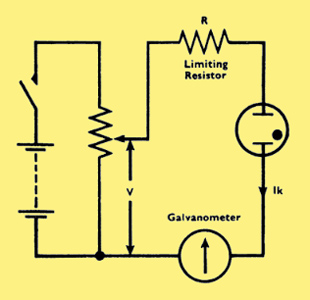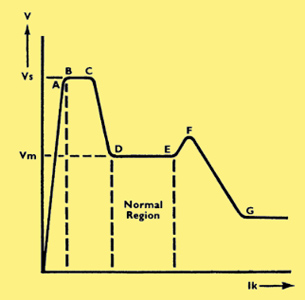|
The following is a brief extract from this book.
Fundamental Characteristics of Gas Discharges
The operation of cold cathode tubes depends upon the conduction of current through a suitable gas at a relatively low pressure. Normally the inert gases, such as argon, neon, etc., either alone or in combination and generally at a pressure less than 0.1 atmospheres, are used in cold cathode tubes.

Fig. 1.
If a potential difference is set up between two electrodes in such an atmosphere the characteristic relating the current between the two electrodes to the potential difference across them can be determined in the circuit shown in Fig. 1. The characteristic is drawn in Fig. 2 in which the current scale is logarithmic.

Fig. 2.
The first stage up to the point (A) on the curve covers a very low current range (of the order of 10-16 to 10-12 A) known as the Townsend current, which flows during the period of the gradual build up of ionised particles. The next stage from (A) to (C) indicates a very rapid increase in the degree of ionisation with a virtual breakdown occurring at the point (B). The voltage at (B) is known as the striking voltage and the value of this voltage depends upon the gas mixture and pressure, the electrode materials and the physical construction or geometry of the tube.
When the discharge has been established the current through the tube is determined by the value of the external limiting resistance. For a range of current the potential drop across the tube stabilises at a value substantially lower than the striking voltage. This is known as the maintaining voltage. This stable region from (D) to (E) where the voltage drop across the tube is substantially independent of the current through it is known as the normal region and is the one generally used in the operation of cold cathode tubes. In this normal condition the discharge is clearly visible, the colour being determined by the gas filling.
If the external resistance is further reduced the nature of the discharge changes. There is an abnormal glow condition from (E) to (F) in which the potential difference across the tube rises as the current rises but subsequently from (F) to (G) the potential drops until the arc condition is reached.
The earliest work on the phenomena of gas discharges was that of Geisler in Germany. Further work carried out by the British physicist Townsend at the beginning of the twentieth century and subsequently by other physicists has established two stages in the mechanism by which the current is conducted through the gas. Initially a certain potential difference between the electrodes results in the ionisation of the gas and subsequently the bombardment of the cathode by the positively charged ions carrying the Townsend current results in electron emission from the cathode surface, these electrons in turn producing ionisation of the gas. It is this electron emission from the surface of the unheated cathode, as the result of ionic bombardment, which distinguishes cold cathode tubes from the better known thermionic valves.
In the same way as the electronic emission from a hot cathode depends upon the cathode material and at a given temperature is greater for materials having a low work function, so in the cold cathode tube the electronic emission depends upon the work function of the cathode surface. A wide range of materials may be used depending upon the characteristics required and in many cases the combination of mechanical and emissive properties is obtained by means of an active coating on a relatively inactive metallic cathode.
It will be realised from the above very brief description of the mechanism of the gas discharge, that the initiation of the Townsend current is dependent upon some residual ionisation in the gas. In practice this necessary minimum is normally provided by the effects of ambient illumination, cosmic radiation, radioactivity, etc.
Cold cathode tubes operate reliably over a very wide range of ambient illumination both in daylight and in artificial light. Excessive illumination however, such as direct sunlight, may result in sufficient ionisation to reduce the strike voltage of cold cathode tubes appreciably below the normal value. On the other hand, the reliable operation of cold cathode tubes in total darkness may call for the use of an ionising agent such as a radioactive material incorporated in the gas or in the mechanical construction of the tube. For example the Hivac XC12T.

A typical Hivac cold cathode tube
See also Cold Cathode Trigger Tubes and their Uses.
|